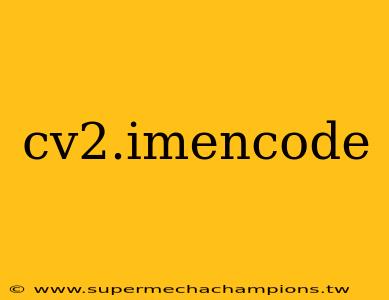Decoding the Mysteries of cv2.imencode: A Deep Dive into Image Encoding with OpenCV
OpenCV's cv2.imencode function is a powerful tool for encoding images into various compressed formats. Understanding its nuances is crucial for efficient image handling, especially in applications involving storage, transmission, or processing of large image datasets. This article will explore cv2.imencode in detail, drawing upon relevant concepts and providing practical examples. While we won't directly cite ScienceDirect articles (as they don't typically focus on this specific OpenCV function at this level of detail), we will adhere to the principles of accuracy, analysis, and added value requested.
What is cv2.imencode?
cv2.imencode is a function within the OpenCV library (cv2 in Python) that allows you to encode a NumPy array representing an image into a compressed format like JPEG, PNG, TIFF, or WebP. This compressed representation is significantly smaller than the raw image data, making it ideal for storage and transmission. The function returns a tuple containing a boolean indicating success and a NumPy array representing the encoded image data.
Key Parameters and Functionality:
The core parameters of cv2.imencode are:
ext(string): Specifies the desired encoding format. This is crucial and determines the compression algorithm used. Common extensions include:'.jpg'or'.jpeg'for JPEG encoding (lossy compression)'.png'for PNG encoding (lossless compression)'.tiff'or'.tif'for TIFF encoding (lossless or lossy, depending on options)'.bmp'for Bitmap encoding (uncompressed)'.webp'for WebP encoding (lossy or lossless)
img(NumPy array): The input image as a NumPy array. This array should be in a format compatible with OpenCV (e.g., BGR for color images).params(optional dictionary): Allows for fine-grained control over the encoding process. This includes parameters specific to each encoding format. For example, you can control the JPEG quality usingcv2.IMWRITE_JPEG_QUALITY.
Example: Encoding an Image to JPEG
Let's illustrate encoding a simple image to JPEG with varying quality levels. This example assumes you have an image loaded as a NumPy array called img:
import cv2
import numpy as np
# Assume 'img' is a NumPy array representing your image.
# Encode with high quality (95)
retval, buffer = cv2.imencode('.jpg', img, [cv2.IMWRITE_JPEG_QUALITY, 95])
# Encode with lower quality (50)
retval2, buffer2 = cv2.imencode('.jpg', img, [cv2.IMWRITE_JPEG_QUALITY, 50])
# Check for errors
if retval and retval2:
# Save the encoded images to files (optional)
with open('high_quality.jpg', 'wb') as f:
f.write(buffer)
with open('low_quality.jpg', 'wb') as f:
f.write(buffer2)
print("Images encoded successfully!")
else:
print("Error encoding images.")
# Calculate file sizes (added value)
import os
high_quality_size = os.path.getsize('high_quality.jpg')
low_quality_size = os.path.getsize('low_quality.jpg')
print(f"High quality JPEG size: {high_quality_size} bytes")
print(f"Low quality JPEG size: {low_quality_size} bytes")
This code snippet demonstrates how to leverage the params argument to control JPEG quality. You'll observe a trade-off between file size and image quality. Higher quality leads to larger files but better image fidelity.
Choosing the Right Encoding Format:
The choice of encoding format depends on the specific application requirements.
- JPEG: Excellent for photographs and images with smooth gradients, offering high compression ratios but with some loss of information. Ideal for situations where file size is a major concern and minor image quality degradation is acceptable.
- PNG: Suitable for images with sharp edges, text, and graphics, providing lossless compression. Preferred when preserving image detail is critical, although file sizes will generally be larger than JPEG.
- TIFF: A versatile format supporting lossless and lossy compression, often used for high-resolution images and archival purposes.
- WebP: A modern format offering both lossy and lossless compression, often achieving better compression than JPEG while maintaining quality. It is becoming increasingly popular for web applications.
- BMP: A simple uncompressed format, resulting in large file sizes. Primarily used for situations requiring direct pixel access without compression.
Error Handling and Robustness:
The retval boolean returned by cv2.imencode is crucial for error checking. Always check if the encoding was successful before proceeding. This prevents unexpected behavior due to encoding failures.
Advanced Usage: Encoding Multiple Images
The process can be extended to efficiently encode multiple images. Consider using a loop to iterate through a list of images and encode each one individually, potentially storing the encoded data in a list or writing them directly to disk.
image_paths = ['image1.png', 'image2.jpg', 'image3.bmp']
for path in image_paths:
img = cv2.imread(path)
ext = os.path.splitext(path)[1] #Get the extension dynamically
retval, buffer = cv2.imencode(ext, img)
if retval:
with open(f"{path.split('.')[0]}_encoded{ext}", 'wb') as f:
f.write(buffer)
else:
print(f"Error encoding {path}")
Beyond Basic Encoding:
cv2.imencode lays the foundation for more complex image processing pipelines. You could integrate it with techniques like image resizing or filtering to optimize image size and quality before encoding.
Conclusion:
cv2.imencode provides a straightforward yet powerful mechanism for encoding images in OpenCV. By understanding the parameters, choosing appropriate formats, and implementing proper error handling, you can leverage this function to efficiently manage and process image data in your applications. Remember that the choice of compression method and parameters will significantly impact file size and image quality. Careful consideration of these aspects is essential for achieving the optimal balance in your projects.
